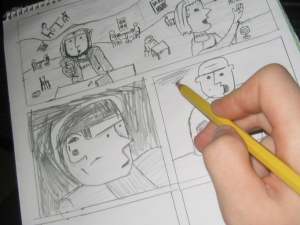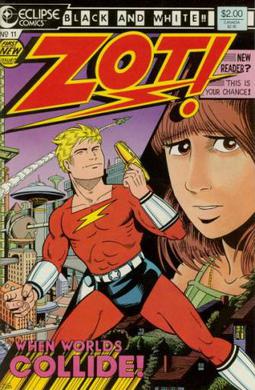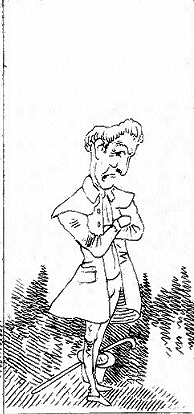
William Erwin Eisner was an American cartoonist, writer, and entrepreneur. He was one of the earliest cartoonists to work in the American comic book industry, and his series The Spirit (1940–1952) was noted for its experiments in content and form. In 1978, he popularized the term "graphic novel" with the publication of his book A Contract with God. He was an early contributor to formal comics studies with his book Comics and Sequential Art (1985). The Eisner Award was named in his honor and is given to recognize achievements each year in the comics medium; he was one of the three inaugural inductees to the Will Eisner Comic Book Hall of Fame.
A graphic novel is a long-form work of sequential art. The term graphic novel is often applied broadly, including fiction, non-fiction, and anthologized work, though this practice is highly contested by comics scholars and industry professionals. It is, at least in the United States, typically distinct from the term comic book, which is generally used for comics periodicals and trade paperbacks.

In comics studies, sequential art is a term proposed by comics artist Will Eisner to describe art forms that use images deployed in a specific order for the purpose of graphic storytelling or conveying information. The best-known example of sequential art is comics.

Comics is a medium used to express ideas with images, often combined with text or other visual information. It typically takes the form of a sequence of panels of images. Textual devices such as speech balloons, captions, and onomatopoeia can indicate dialogue, narration, sound effects, or other information. There is no consensus among theorists and historians on a definition of comics; some emphasize the combination of images and text, some sequentiality or other image relations, and others historical aspects such as mass reproduction or the use of recurring characters. Cartooning and other forms of illustration are the most common image-making means in comics; Photo comics is a form that uses photographic images. Common forms include comic strips, editorial and gag cartoons, and comic books. Since the late 20th century, bound volumes such as graphic novels, comic albums, and tankōbon have become increasingly common, along with webcomics as well as scientific/medical comics.

Scott McCloud is an American cartoonist and comics theorist. He is best known for his non-fiction books about comics: Understanding Comics (1993), Reinventing Comics (2000), and Making Comics (2006), all of which also use the medium of comics.

The Spirit is a fictional masked crimefighter appearing in American comic books. Created by cartoonist Will Eisner, he first appeared as the main feature of a tabloid-sized comic book insert distributed in the Sunday edition of Register and Tribune Syndicate newspapers. Popularly referred to as "The Spirit Section", the insert ran from June 2, 1940 to October 5, 1952.

Comics and Sequential Art is a book by American cartoonist Will Eisner that analyzes the comics medium, published in 1985 and revised in 1990. It is based on a series of essays that appeared in The Spirit magazine, themselves based on Eisner's experience teaching a course on comics at the School of Visual Arts. It is not presented as a teaching guide, however, but as a series of demonstrations of principles and methods. A 1990 expanded edition of the book includes short sections on the print process and the use of computers in comics. Eisner followed with a companion volume, Graphic Storytelling and Visual Narrative, in 1996.

Zot! is a comic book created by Scott McCloud in 1984 and published by Eclipse Comics until 1990 as a lighthearted alternative to the darker and more violent comics that dominated the industry during that period. There were a total of 36 issues, with the first ten in color and the remainder in black and white.

Kitchen Sink Press was a comic book publishing company founded by Denis Kitchen in 1970. Kitchen Sink Press was a pioneering publisher of underground comics, and was also responsible for numerous republications of classic comic strips in hardcover and softcover volumes. One of their best-known products was the first full reprint of Will Eisner's The Spirit—first in magazine format, then in standard comic book format. The company closed in 1999.
European comics are comics produced in Europe. The comic album is a very common printed medium. The typical album is printed in large format, generally with high quality paper and colouring, commonly 24x32 cm, has around 48–60 pages, but examples with more than 100 pages are common. While sometimes referred to as graphic novels, this term is rarely used in Europe, and is not always applicable as albums often consist of separate short stories, placing them somewhere halfway between a comic book and a graphic novel. The European comic genres vary from the humorous adventure vein, such as The Adventures of Tintin and Asterix, to more adult subjects like Tex Willer, Diabolik, and Thorgal.

A Contract with God and Other Tenement Stories is a graphic novel by American cartoonist Will Eisner published in 1978. The book's short story cycle revolves around poor Jewish characters who live in a tenement in New York City. Eisner produced two sequels set in the same tenement: A Life Force in 1988, and Dropsie Avenue in 1995. Though the term "graphic novel" did not originate with Eisner, the book is credited with popularizing its use.

Denis Kitchen is an American underground cartoonist, publisher, author, agent, and the founder of the Comic Book Legal Defense Fund.

Histoire de Mr. Vieux Bois, published in English as The Adventures of Mr. Obadiah Oldbuck, is a 19th-century publication written and illustrated by the Swiss caricaturist Rodolphe Töpffer.

Making Comics: Storytelling Secrets of Comics, Manga, and Graphic Novels is a book by comic book writer and artist Scott McCloud, published by William Morrow Paperbacks in 2006. A study of methods of constructing comics, it is a thematic sequel to McCloud's critically acclaimed books Understanding Comics and Reinventing Comics.

Masking is a visual style used in comics, first described by American cartoonist Scott McCloud in his book Understanding Comics: The Invisible Art. McCloud argues that characters with simple but recognizable designs, which he terms "iconic" characters, allow readers to project themselves into the story by using the characters as a "mask". He further argues that the juxtaposition of iconic characters with detailed backgrounds, characters, or objects can create meaning and strengthen or weaken readers' emotional and psychological connection to certain elements of the graphic narrative.
The use of comics in education is based on the concept of creating engagement and motivation for students.
The history of comics has followed different paths in different parts of the world. It can be traced back to early precursors such as Trajan's Column, in Rome, Egyptian hieroglyphs and the Bayeux Tapestry.
Comics studies is an academic field that focuses on comics and sequential art. Although comics and graphic novels have been generally dismissed as less relevant pop culture texts, scholars in fields such as semiotics, aesthetics, sociology, composition studies and cultural studies are now re-considering comics and graphic novels as complex texts deserving of serious scholarly study.
Comics has developed specialized terminology. Several attempts have been made to formalize and define the terminology of comics by authors such as Will Eisner, Scott McCloud, R. C. Harvey and Dylan Horrocks. Much of the terminology in English is under dispute, so this page will list and describe the most common terms used in comics.

Sequart Organization is an online magazine that focuses on the study of popular culture and the promotion of comic books as an art form. Sequart also publishes books and produces documentary films. It was founded in 1996 by Julian Darius. Sequart's editor-in-chief is Mike Phillips.














